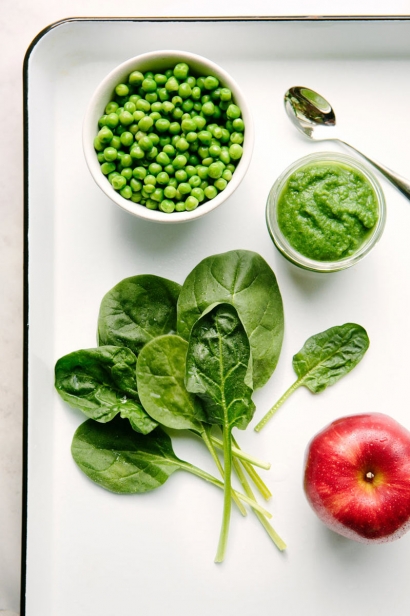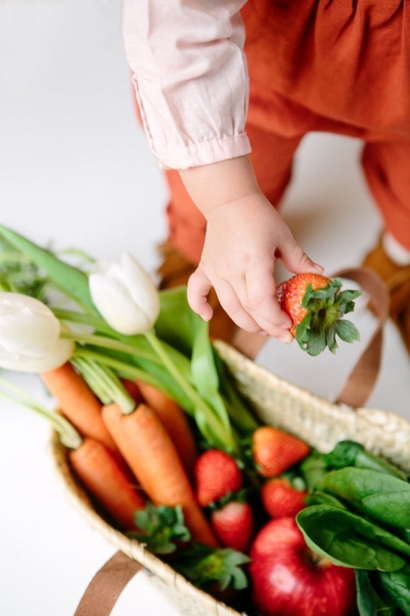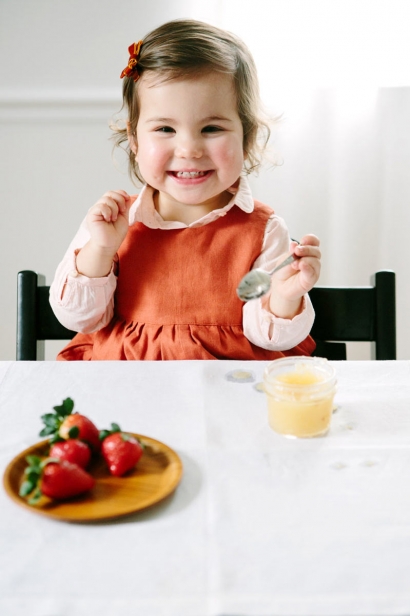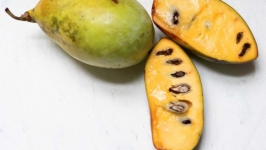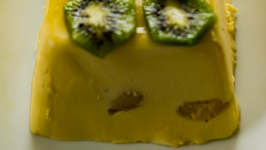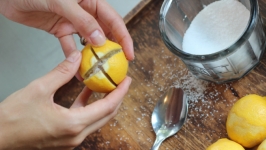Making Baby Food at Home
Baby food is an early opportunity to introduce a child to varied and nutritious meals. Making baby food at home gives parents a chance to source ingredients locally when possible and feed their babies around seasonal harvests. Local mom and professional food and prop stylist, Bridget Henry, knows a thing or two about cultivating the culinary in her child from an early start. Guided by Montessori principles and a love of local, Bridget makes cooking for her daughter, Bianca, a top priority.
Bianca, now 1½ years old, has an ever-present smile stretched between her rosy cheeks. Even while eating lunch, ravioli clenched tightly in her tiny hands and more lost in her chestnut brown hair, Bianca grins wide and chatters away. She can’t say it yet, but it’s clear that she loves to eat. And no wonder. Bridget has been devoted to making Bianca fresh and wholesome baby food ever since she could eat it. As Bianca transitioned from breast milk to rice cereal, then to purées and soft foods, Bridget made a concerted effort to prepare Bianca’s food in their home kitchen using organic and locally sourced ingredients in simple preparations. Now at 1½, there are only few things Bianca won’t happily eat.
“She loves everything,” says Bridget. “She’s loved carrots ever since she had one.”
With a baby’s transition from breast milk or formula to cereals and purées, often called “Stage 1,” comes the opportunity to introduce new colors, textures and ingredients. Most babies enter this phase between 4 and 6 months of age when they are receptive to new flavors.
According to pediatrician at Step by Step Pediatrics, Dr. Mary-Lynn Niland, “Stage 1 includes puréed single-ingredient fruits and vegetables. No food (with the exception of honey in the first year) is off limits. Babies should be offered a variety of healthy foods—fruits, vegetables, grains, legumes, meats, eggs, dairy.”
“I started Bianca with rice cereal and then Stage 1 purées,” says Bridget. “The rice cereal is an important step. You mix it with your breast milk or formula. After a few days, I went into the purées,” she adds.
Because purées are so simple—typically just steamed fruit or vegetables and water—the quality of the ingredients is imperative. In season, Bridget scours farmers markets for fresh produce but supplements her shopping at the grocery store and Tensuke Market, a local Japanese market. She chooses organic produce that falls in the “Dirty Dozen,” a list of fruits and vegetables most susceptible to harmful pesticides, but doesn’t shop for organic ingredients exclusively.
“I do buy local things for her,” says Bridget, “like milk and eggs.” Snowville Creamery whole milk out of Athens, Ohio, is a favorite in their household.
Thoughtful meal preparation doesn’t stop at ingredients. Bridget is intentional about every element of Bianca’s eating experience. She chooses glass jars and wooden plates, silver utensils and other natural, reusable materials.
This Montessori Method reinforces that young children can learn to eat independently by feeding themselves, with some assistance, to ingrain lifelong skills from an early age. Sippy cups and plastic utensils aren’t necessary, as learning to use a real cup and bring a spoon to their mouth is part of a child’s learning experience. It may be messier at first, but the child will eventually understand the consequences to their actions and can eat, in a high chair, at the family table.
Even when Bridget made Bianca’s purées for her Stage 1 meals in larger batches, she found methods to safely store and reheat individual servings. One of her favorite tools was the ice cube tray, preferably one with a lid. After Bridget made a purée from steamed fruit or veggies, she portioned it into the ice cube tray, snapped on the lid and froze it until needed. When it was time for Bianca to eat, Bridget popped out a cube, placed it in a glass container and reheated the purée in simmering water.
Bridget recommends for a Stage 1 eater, identifying some favorite flavors and making slight variations on those. If your baby loves apples, try an apple-pear purée, or mix apples and sweet potatoes. Rehydrated prunes or raisins can be puréed with steamed apples, too. Even if there’s some apprehension up front—not all babies will gravitate toward peas or cauliflower in the first trial—be persistent with new flavors.
“Parents shouldn't be discouraged if their infant rejects a food, as it sometimes takes 15–20 times of offering a food for a baby or child to accept and enjoy it,” says Mary-Lynn.
With Bianca, Bridget focused on “getting her used to different colors and different textures. “We started with sweet potatoes then moved to carrots and butternut squash,” she says.
“Throughout the stages you change the texture,” says Bridget. “In Stage 1 the purée is a little thinner, so we’d add water.” In Stage 2, often around 8–10 months of age, more flavors can be mixed and spices can be introduced. “Gradually make the purée thicker to incorporate more chewing,” says Bridget.
“Stage 2 foods include slightly thicker puréed fruits and vegetables as well as puréed meats,” says Mary-Lynn. “Stage 3 foods or ‘finger foods’ include small pieces of a variety of foods. Babies can be offered finger foods when they have developed a pincer grasp, with the ability to pick up objects with their thumb and index finger,” she adds.
By Stage 3, typically the last few months of the baby’s first year, food can be prepared in soft chunks and small pieces. “A method of infant feeding that is becoming more and more popular is Baby-Led Weaning,” says Mary-Lynn. “This entails feeding the infant what the rest of the family is eating, with the food items mashed up or shredded into small, soft pieces.”
Bridget keeps a binder handy in her kitchen cabinet. Inside are recipes she’s saved for Bianca ranging from Stages 1–3 and beyond, a log of Bianca’s eating habits, her favorite foods and notes. Many of Bridget’s recipes come from Pinterest and blogs like “Baby FoodE,” but the number of cookbooks devoted to wholesome and creative cooking for babies and children is mounting. In a book called Cooking for Kids: From Babies to Toddlers: Simple, Healthy, and Natural Food by French chef Alain Ducasse, Bridget has flagged recipes like curried fish and veggie-laden pasta, inspiration for Bianca’s future meals.
Bridget’s husband, Helder Delgado, doesn’t have a hard time convincing Bianca, now in Stage 3, to try new or unusual foods.
“I give her anything I eat,” says Helder. She loves fruit, including some varieties that Helder’s Peruvian upbringing makes him more accustomed to, like starfruit and papaya.
“Helder will eat a whole lime, and she’ll just suck on a lime,” says Bridget.
Hanging beneath a chalkboard in their living room, not far from Bianca’s play kitchen where she “makes coffee” each morning, is a small market bag. As Bianca grows, Bridget is eager to create memories with her at the farmers market and widen her experiences with fresh ingredients and home cooking. Preparing Bianca’s food has allowed Bridget to keep a close connection to the process from start to finish.
“I love making her food because then I know what’s in it," says Bridget. "It feels good to make her food.”
Food styling by Bridget Henry





